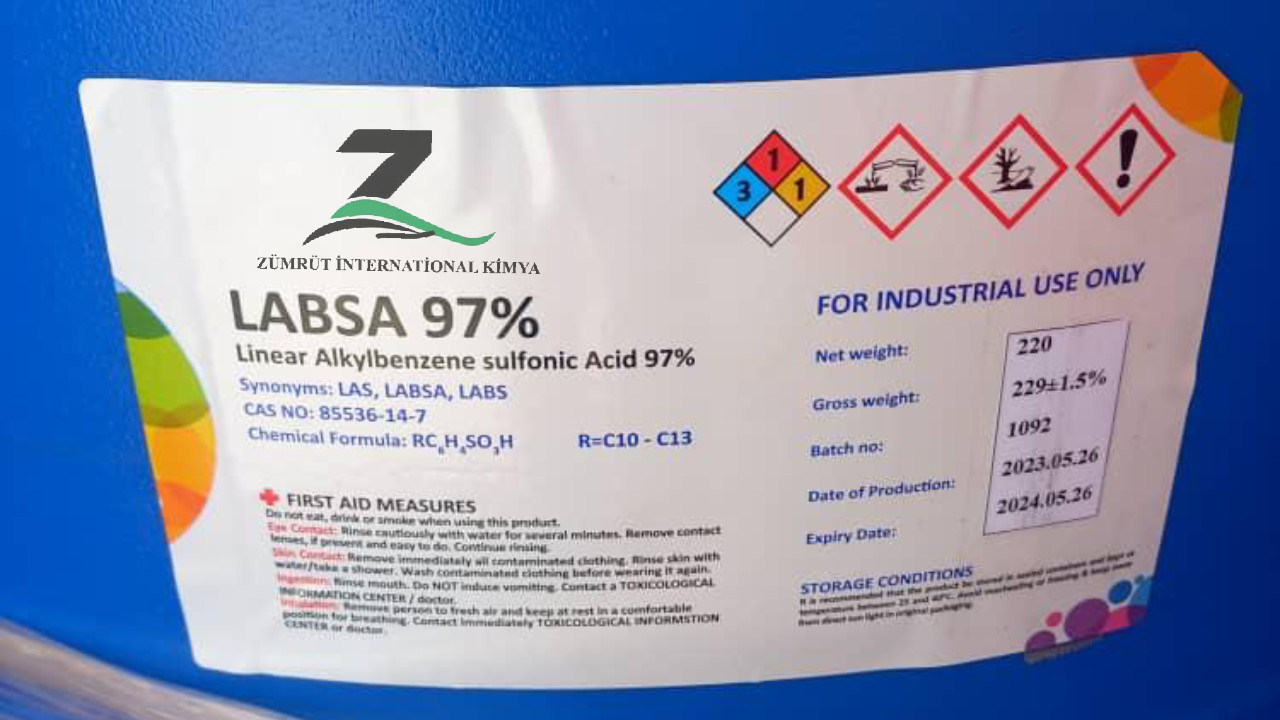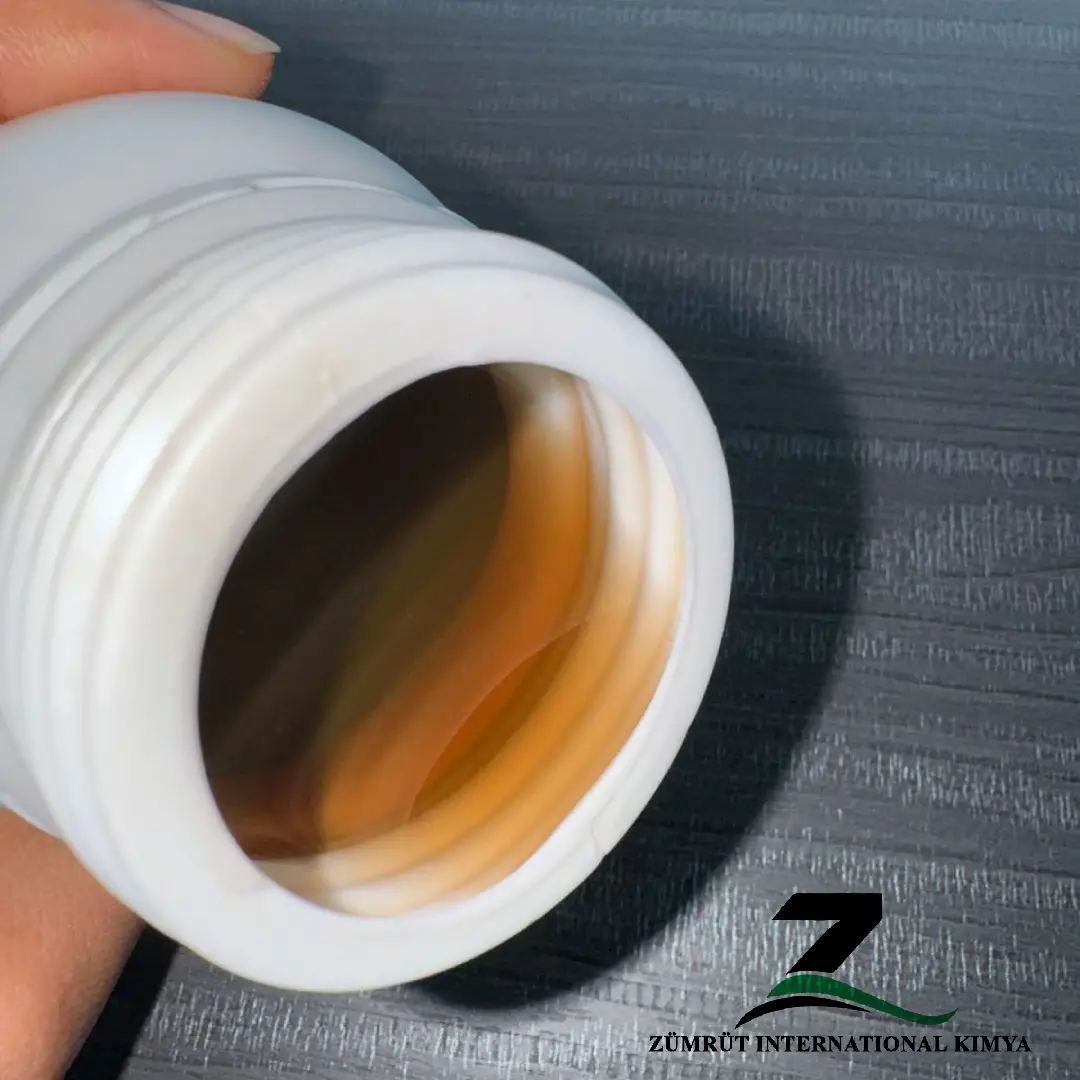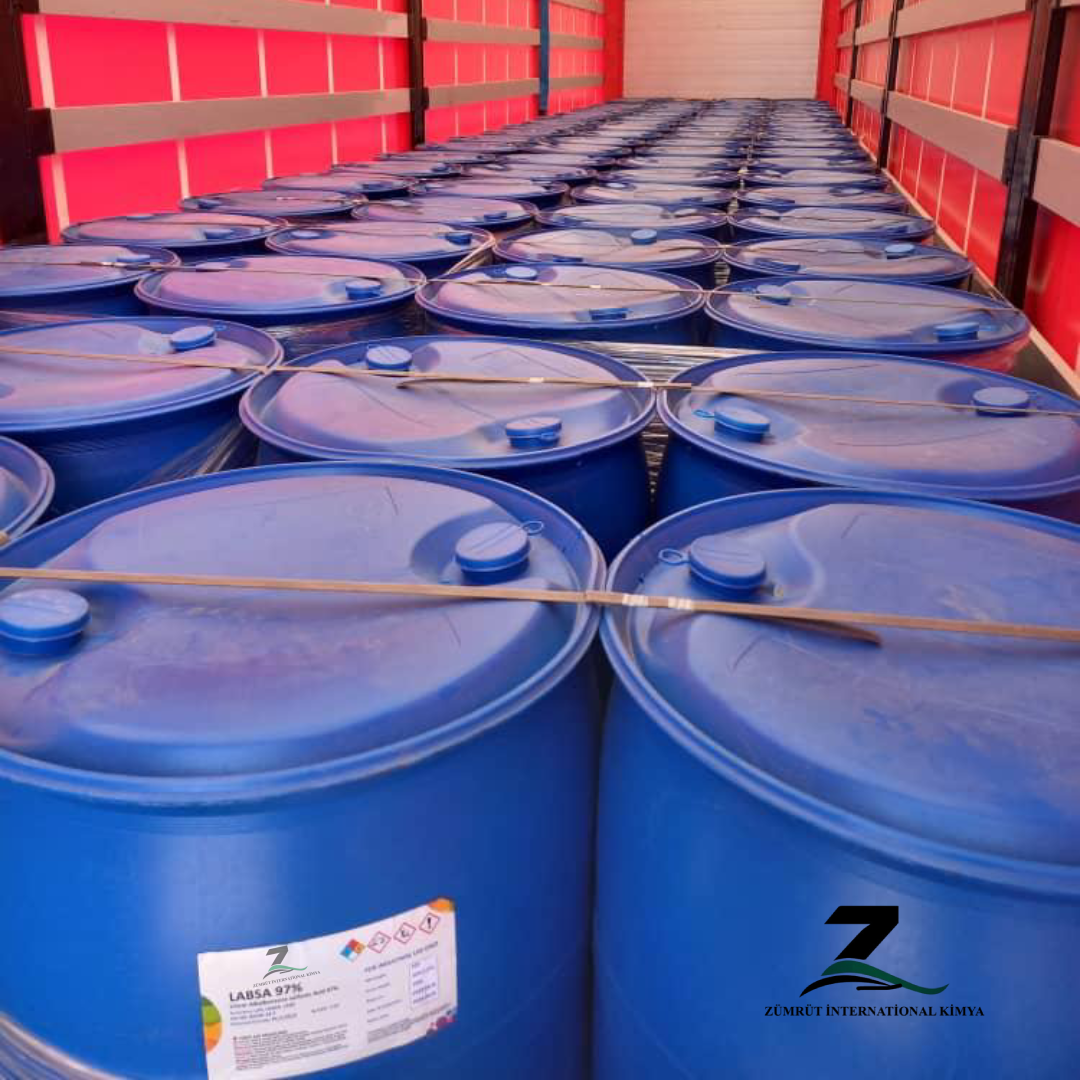
What is LABSA ?
(LABSA)LINEAR ALKYL BENZENE SULFONIC ACID stands for Linear Alkyl Benzene Sulphonic Acid. It is a widely used surfactant in the production of detergents and cleaning products. LABSA is valued for its effectiveness in removing dirt and grease and is commonly used in both household and industrial cleaning applications. It is biodegradable and considered environmentally friendly compared to some other surfactants.
LABSA is an anionic surfactant whose molecules are characterized by a hydrophilic and hydrophobic group. This non-volatile chemical compound is synthesized through the sulfonation process. Sulfonation reagents include sulfuric acid, chlorosulfonic acid, sulfamic acid and diluted sulfur trioxide. The properties of LABSA differ in chemical and physical properties depending on the length of the alkyl chain. This results in formulations that find many applications. The resulting surfactants are used in the chemical industry to improve the contact between water and minerals. Most anionic surfactants, including LABSA, are non-toxic in nature. However, prolonged exposure to these surfactants can irritate and damage the skin through disruption of the lipid membrane that protects the skin and other cells. On the other hand, biodegradability is determined by the hydrophobic hydrocarbon group of the surfactant. LABSA is one of the largest synthetic surfactants by volume due to its low cost and high performance. Apart from that, Linear alkyl benzene sulfonic acid can be dried in the form of a stable powder. This chemical is biodegradable and environmentally friendly. This substance and its derivatives are widely used chemical compounds in the industry of beauty and personal care products. It is also used as a raw material for the production of caprolactam, a precursor of nylon. In this reaction, hydrogen sulfide is used as an equivalent of elemental sulfur. In some cases, the above substance can be used as an additive in special racing car fuels because it helps to ignite their fuel quickly. LABSA is a purple liquid and has various uses due to its surfactant properties.
WHAT ARE THE LABSA USAGE AREAS (PROCESSES)
LINEAR ALKYL BENZENE SULFONIC ACID (LABSA) is used in various applications and processes, primarily due to its effectiveness as a surfactant. Here are some key usage areas:
- Detergent Production:
– Laundry Detergents: LABSA is a primary ingredient in many laundry detergents, both in powder and liquid forms.
– Dishwashing Liquids: It is used in dishwashing liquids to enhance cleaning efficiency and grease removal.
– Industrial Cleaners: Employed in formulations for heavy-duty industrial cleaning agents. - Household Cleaning Products:
– All-Purpose Cleaners: Used in general-purpose cleaners for its ability to break down and remove dirt and grime.
– Bathroom Cleaners: Effective in formulations for cleaning bathroom surfaces. - Personal Care Products:
– Shampoos: Included in some shampoo formulations for its foaming and cleaning properties.
– Hand Soaps: Used in liquid hand soaps for its ability to clean and produce lather. - Textile Industry:
– Washing and Scouring: Utilized in textile processing to clean and prepare fabrics. - Oil and Gas Industry:
– Oil Field Chemicals: Employed in enhanced oil recovery processes and drilling mud formulations. - Leather Industry:
– Leather Processing: Used in the degreasing and cleaning stages of leather processing. - Agriculture:
– Herbicides and Pesticides: Included in formulations to improve the spreading and penetration of active ingredients.
In Which Sectors Is LINEAR ALKYL BENZENE SULFONIC ACID Application
LINEAR ALKYL BENZENE SULFONIC ACID (LABSA) finds application across several sectors due to its surfactant properties. Here are some key sectors where LABSA is widely used:
- Consumer Goods:
– Household Cleaning Products: Includes laundry detergents, dishwashing liquids, and all-purpose cleaners.
– Personal Care Products: Such as shampoos and hand soaps. - Industrial and Institutional Cleaning:
– Industrial Cleaners: Heavy-duty cleaning agents for manufacturing and maintenance.
– Institutional Cleaners: Products used in schools, hospitals, and other public institutions. - Textile Industry:
– Fabric Care: In washing and scouring processes to clean and prepare fabrics for further processing. - Oil and Gas Industry:
– Oil Field Chemicals: Used in enhanced oil recovery, drilling muds, and other oil field applications. - Leather Industry:
– Leather Processing: Employed in the cleaning and degreasing stages of leather production. - Agriculture:
– Agricultural Chemicals: In herbicide and pesticide formulations to improve the efficacy of the active ingredients. - Construction Industry:
– Concrete Additives: Occasionally used in formulations to improve the properties of concrete and other building materials. - Paints and Coatings:
– Emulsifiers: Used in certain formulations to improve the stability and application properties of paints and coatings. - Metalworking:
– Metal Cleaning: In metal cleaning and treatment processes to remove oils, grease, and other contaminants.
WHAT ARE THE CHARACTERISTICS OF LINEAR ALKYL BENZENE SULFONIC ACID (LABSA)
LINEAR ALKYL BENZENE SULFONIC ACID (LABSA) has several notable characteristics that make it a widely used surfactant in various applications. These characteristics include:
- Excellent Surfactant Properties:
– High Detergency: LABSA is highly effective at removing dirt, grease, and oil, making it an excellent cleaning agent.
– Good Foaming Ability: It produces a stable and rich foam, which is beneficial in many cleaning applications. - Chemical Stability:
– Stable in Acidic and Neutral Conditions: LABSA remains effective across a range of pH levels, particularly in acidic and neutral environments. - Biodegradability:
– Environmentally Friendly: LABSA is biodegradable, which makes it a preferable choice over some other surfactants that may be more persistent in the environment. - Compatibility:
– Versatile with Other Ingredients: LABSA can be easily formulated with other ingredients, enhancing its effectiveness in various products.
– Solubility: It is soluble in water, which aids in its application in aqueous solutions. - Cost-Effectiveness:
– Economical: LABSA is relatively inexpensive to produce, contributing to its widespread use in the detergent and cleaning product industries. - Form:
– Viscous Liquid: LABSA is typically a brown, viscous liquid at room temperature.
– Ease of Handling: It can be easily handled and processed in manufacturing environments. - Corrosive Nature:
– Corrosive: LABSA is a strong acid and can be corrosive, requiring appropriate handling and storage measures to ensure safety. - Performance in Hard Water:
– Effective in Hard Water: LABSA maintains its cleaning efficacy even in the presence of hard water, making it suitable for various water conditions.
PACKING OF LINEAR ALKYL BENZENE SULFONIC ACID (LABSA)
- LABSA Packed in new PE drum, and IBC tank.
- Each 20-foot container takes 80 drums

ENVIRONMENTAL AND SAFETY CONSIDERATIONS
Most anionic surfactants including LABSA are nontoxic in nature. However, prolonged exposure to these surfactants, could irritate and damage the skin through the disruption of the lipid membrane, which protects the skin and other cells. On the other hand, the biodegradability is determined by surfactant’s hydrophobic hydrocarbon group.
What does the LABSA look like?
In liquid form, it is orange, light brown in color.
How is LABSA produced?
LABSA is obtained after the reaction of LAB, which is Linear Alkyl Benzene, with SO3. This process is called sulfonation
Advantages of LABSA
Linear Alkylbenzene Sulfonic Acid (LABSA) is a widely used anionic surfactant, primarily in the production of detergents and cleaning agents. Here are the main advantages of LABSA:
- High Detergency Power
LABSA has excellent detergency, making it highly effective in removing dirt, grease, and stains from various surfaces. This makes it a primary ingredient in both household and industrial cleaning products, including laundry detergents and dishwashing liquids. - Cost-Effective
LABSA is relatively inexpensive to produce, making it a cost-effective choice for manufacturers. It helps reduce the overall production costs of detergents and cleaning products without compromising performance. - Biodegradability
LABSA is more biodegradable than some other surfactants, such as branched-chain alkylbenzene sulfonates (BAS). Its linear structure allows it to break down more easily in the environment, reducing its ecological impact. - Stable Under Various Conditions
LABSA remains stable across a wide range of pH levels, temperatures, and water hardness. This makes it suitable for use in diverse formulations and environments, from acidic cleaners to neutral detergents. - Compatibility with Other Surfactants
LABSA is compatible with other surfactants, especially non-ionic and cationic surfactants. This allows manufacturers to create blended formulations that enhance cleaning efficiency and foam production. - Versatility
LABSA is used in a wide variety of cleaning applications, including:
Laundry detergents (powder, liquid, and bar soap)
Dishwashing liquids
Industrial and institutional cleaners
Emulsion polymerization
Textile processing and leather processing - Foaming Ability
LABSA produces abundant and stable foam, which is a desirable property in many cleaning products, particularly in hand wash detergents and dishwashing liquids. It enhances the consumer experience by providing visual feedback of cleaning performance. - Strong Wetting and Emulsifying Properties
LABSA’s strong wetting ability allows it to spread easily over surfaces, enhancing the efficiency of cleaning agents. Its emulsifying properties help to disperse oils and greasy substances in water, ensuring effective removal of stains. - Non-Toxic and Safe for Human Use
LABSA is non-toxic and safe for use in household cleaning products. It is commonly used in concentrations that are safe for human contact, such as in laundry detergents and dishwashing liquids. - Good Solubility
LABSA is highly soluble in water, which facilitates its use in liquid detergent formulations. This good solubility also helps ensure even distribution in cleaning solutions and prevents product separation. - Environmental Benefits
The biodegradability and relatively low toxicity of LABSA contribute to its being an environmentally friendlier option compared to other non-biodegradable surfactants. This minimizes its impact on aquatic life and ecosystems.

TECHNICAL DATA SHEET OF LINEAR ALKYL BENZENE SULFONIC ACID (LABSA)
| SPECIFICATION | STANDARD | RESULTS | UNCERTAINTY IN MEASUREMENT | ISIRI NO |
| Molecular weight(g/mol) | 323 | 323 | ± 0.2 | ISIRI 12028 |
| Free Oil | Max 2.0 | 1.59 | ± 0.05 | ISIRI 3513 |
| Active Matter % | (96-98) | 96.2 | ± 0.2 | ISIRI 3513 |
| Color (Klett)((4%(w/w)) | Max 70 | 13 | ± 1 | ISIRI 3513 |
| Sulfuric Acid % | Max 1.8 | 1.74 | ± 0.05 | ISIRI 3513 |
| Water % | Max 0.5 | 0.45 | ± 0.02 | ISIRI 18481 |
| Appearance | 60.05g/molBrown viscose liquid | Light Brown viscose liquid | – | ISIRI 3513 |



